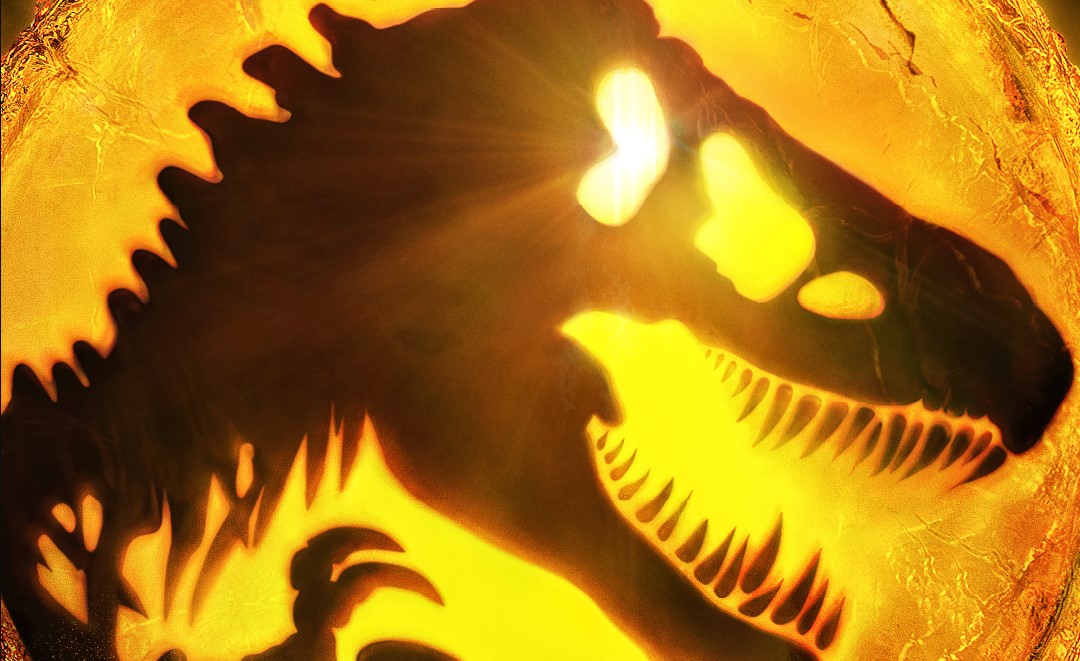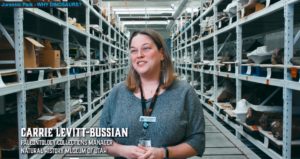Over the course of 29 years and six movies, Jurassic Park has changed how we look and think about dinosaurs.
It’s rekindled interest in the creatures from those of us who thought our dino days were behind us, and sparked a love for them among many millions of fans. But there’s so much more. There’s so much science to be learned.
We called up our favorite paleontologist, Jimmy Waldron – host of the Dinosaurs Will Always Be Awesome podcast to run down five science takeaways that use Jurassic Park as a springboard to dig into some cool real-world dinosaur science.
Before we get started, let’s remember: Jurassic Park was never meant to be a documentary about dinosaurs. We have Prehistoric Planet and others for that. No, Jurassic Park was, and always will be a thrilling story. But it’s the kind of story we love best – one that can act as a fun gateway for learning about the real science behind the story. Let’s get into it…
#5: We have a much better idea of what Jurassic Park’s creatures actually looked like now than we did then.
There were decisions made about how the dinosaurs looked in Jurassic Park, and we understand that. But using the films as a jumping-in point, there’s so much more that we now know about how dinosaurs looked.
Take, for example, the Dilophosaurus. The dino from the first movie that was curious about Nedry (Wayne Knight), then popped frills and spat venomous goo on him. Not quite.
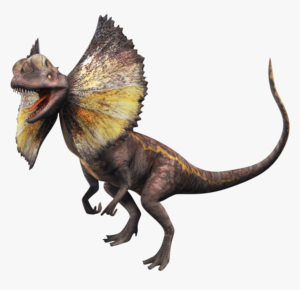
The Jurassic Park version of a dilophosaurus. A little more and a lot less than a real one. Image – Universal Studios
“Dilophosaurus stood 10-feet tall, with keratinized crests – like a cassowary, but double trouble,” Waldron says. “It was an apex predator for its particular region during the Jurassic period, and the frill? Maybe InGen scientists mixed some frilled lizard DNA to fill in the holes and complete the code, but the real thing wasn’t that fancy.”
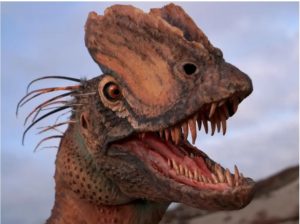
A more realistic-looking dilophosaurus. No frills needed. Brian Engh, commissioned by The Saint George Dinosaur Discovery Site
Also, as Waldron explains, none of the theropod dinosaurs, which include everyone from the T. Rex to the velociraptors kept their dinosaur hands hanging, with the toes/fingers curled inwards. It’s just not how they were built.
“Dinosaurs had bilateral symmetry, and the structures of their arms – or…wings? – forelimbs were strikingly similar to ours,” Waldron says. “If you stand with your hands at your side, your thumbs should point forward. It’s the same in dinosaurs, where the palms of their paws would face inward most of the time.”
And of course, the feather thing. It was a branch of theropods that evolved into our modern-day birds, so, looking backwards, it’s easy to assume that many or even all of their ancestor dinosaurs had feathers. But that idea wasn’t getting too much traction until the late ‘90s. Sure, there was Archaeopteryx, with its feathers, but feathers on most dinosaurs? Nah. And never mind that the special effects team was sweating to make believable dinosaurs, let alone believable dinosaurs with feathers when the first Jurassic Park hit theaters. But in Dominion, glorious, feathered dinos!
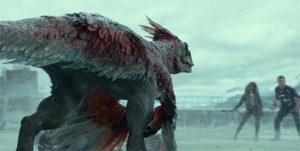
Who’s a pretty boy? Image – Universal Studios
But while the feather-covered dino feels like a recent addition to the knowledge base, the idea actually has its roots at the start of paleontology, and the first dinosaur fossils. English naturalist Thomas Huxley noted that the dinosaur skeletons being shown at the time had proportions that were much more bird-like than lizard-like.
“When the first Jurassic Park came out, the idea of dinosaurs as big, scaly creatures was just the norm at the time,” Waldron says. “And that’s partly a result of our different approach to pulling bones out of the ground. We’ve gotten even more meticulous and more careful in our preparation methods. So we’re now more likely to notice little things like feather indentations on bones, or little bits of skin and matrix on the outside of the bones. Whereas in the decades leading up to this, the focus was to get as many bones out of the ground and into the museum, as fast you can.”
Since the initial film’s release the idea of feathered, colorful, perhaps even dancing dinosaurs has taken hold both in paleontology and with the audience. The feathers in Dominion will be no surprise.
#4: Velociraptor was a stage name
Okay – this one takes on an almost personal crusade for Waldron. The Velociraptors of Jurassic Park are not Velociraptors. They’re Deinonychus.
Yeah. Childhood: ruined.
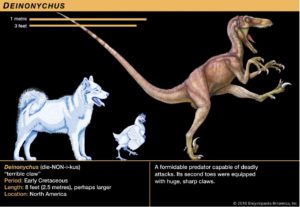
There’s your terror of the kitchen – deinonychus. Image – Britannica
“During the development of the original Jurassic Park novel, Michael Crichton consulted Dr. John Ostrom, who discovered the fleet-footed Deinonychus on February 25th, 1961.” Waldron explains. “An incredibly important specimen, because its hollow bones and leg bone ratios gave us the first concrete evidence of dinosaurs being agile and bird-like, instead of the sluggish ectotherms we’d originally anticipated. The villains of the story were built with the dimensions, ecological roles, and behaviors of Deinonychus antirrhopus. But when it came time to go to press, the dinosaurs’ name was changed to the more scary-sounding Velociraptor, to more heavily lean on the bird-of-prey themes from the beginning of the novel.
The name Velociraptor, according to Waldron, was spotted as a footnote in an old issue of National Geographic when the book was readying to go to print, and was selected to be used because it sounded, well, cooler. But really, Velociraptors were smaller, feathered, and, aside from the toe claw, even kind of…cute?
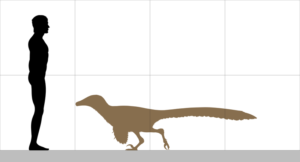
Actual Velociraptors weren’t all that big. Image Credit: PaleoNeolitic, https://commons.wikimedia.org/wiki/File:Velociraptor_size.png
And while we’re talking about the Deinonychus, er, Velociraptors, that flocking and hunting in a pack view that the movies give? Okay, that’s probably spot-on, and has been slowly becoming more of a certainty over the last couple of decades. How do paleontologists know? By looking at the evidence.
“We base a lot of our ideas about dinosaur behavior on homology and by looking at other species that share similar structures,” Waldron says. “Occasionally, we can translate those similarities to behaviors because during their time, dinosaurs filled every ecological niche in the world. The world of the dinosaurs had virtually the same niches that we have today, so these jobs that animals do in the wild now had openings back during the Mesozoic period and dinosaurs fulfilled them.”
So that’s for the roles dinosaurs played in the ecosystem, but as for their specific hunting styles? That’s based on dinosaur tracks. Occasionally, dinosaur tracks will have been laid down in close proximity to one another, and within a very similar timeframe.
“Typically they show up in the same layer and at the same time,” Waldron says. “When we find multiple kinds of raptor-type footprints, we can start to say, ‘Hey, look, here’s a family group.’ Or identify a clutch of multiple adults moving in the same direction at the same time, in a way that doesn’t look like they’re competitive – they’re not running and chasing each other, and are moving in groups.
“So we take that grouping idea, and then we look at how other animals that work in groups move, and from that we’re able to draw the conclusion that the Velociraptor and Deinonychus may have hunted in groups or worked together when necessary for taking down larger prey.”
#3: The Amber thing? Totally real. Mr. DNA? A Little Optimistic for 1993.
“While writing the original novel, Michael Crichton consulted with Dr. George O. Poinar – author of The Amber Forest – which involved high-magnification photos of amber inclusions – animals and plants trapped within the hardening sap,” Waldron says. “Without access to oxygen or outside detritivores, animals like lizards, insects, birds—and even dinosaur tails—are remarkably preserved, capturing details and elements of their prehistoric ecosystem. We’ve even found pieces of amber with pockets of water still within.”
But – a caveat. And to be fair, this is one we’ve known probably since Jurassic Park hit: the DNA trapped inside, even inside the preservation heaven of amber, isn’t going to be complete. Though nothing can get into the amber to “attack” the DNA, the DNA can’t protect itself from the effects of time.
“DNA decays over time, with a half-life of around 520 years,” Waldron says. “After that long, half of the DNA will have decayed to its bare molecules. So basically, you’ve got the full volume of Harry Potter broken down to a collection of repeating vowels, but with no punctuation. And every 520 years you rip half the pages out. And after 65 million years, you don’t have a really cohesive story anymore or barely even letters. Best, best case, there might be some really super-short fragments if everything is going your way.”
Early 90s tech just wasn’t there yet – it wasn’t close to being able to reconstituting full dinosaur DNA from the blood found in a mosquito stuck in amber, and also, because the DNA wouldn’t be there. That was a liberal dose of the fiction in the “science fiction” of the story.
But the science is getting better. Maybe in the early Mr. DNA days, scientists would be able to tell what they were looking at had been a book at one time. Now, we’re getting better at reading chapters, and before long, we’ll be able to string together a few coherent sentences. It’s still looking at relatively recently-extinct animals though – somewhere between now and 700,000 years ago. It’s a slow, difficult process, but bits of DNA can be spun up from fossils and tissue remains.
“This is why you’re seeing these de-extinction projects that are starting up, like the group that wants to restore the mammoth and there’s a lot of talk about bringing back thylacines and dodos from existing samples that we have in museums and zoos and places where we could find little remnants of their DNA. I remember reading an article back in ‘93 saying that Jurassic Park wasn’t science fiction, it was gonna be science eventuality.”
All of the above however, doesn’t mean we don’t have some soft tissue from dinosaurs, though. For that, let’s talk about:
#2: A whole new field of paleontology emerged from Jurassic Park; financed in part by Jurassic Park.
“Some of the earliest de-extinction research and fossil genetic mapping research was developed with the support of the Jurassic Foundation – a scientific organization created by Steven Spielberg and Universal using proceeds from the movie,” Waldron says. “Each year, the Jurassic Foundation awards monetary prizes to scientists and researchers creating innovations in paleontology and paleogenomics.”

Yeah, speaking of that latter one…
Without Jurassic Park and its kin, it could be argued that the field of paleogenomics might not be as fully developed as it is today. The discipline is relatively new on the scene, and does exactly what the name suggests – studies fossil remains in search of genetic material and then applies modern molecular biology to it. That material can include proteins, genetic residues, pollen, preserved plant matter, and if you’re really lucky, soft tissue within a T. rex leg bone.
The news may have made you raise an eyebrow when it was reported in 2005 (and there have been subsequent finds in the years since): soft tissue had been found in a T. rex fossil. How it was discovered and the fact that it was there at all…better than a movie storyline.
For an animal to be fossilized, it has to die near water and fall into the water and/or get covered by silt. The covering creates an anaerobic environment that holds off scavengers and full-on decomposition, and allows the magic to happen. Decay happens slowly, allowing permineralization to happen in tandem.
“Individual bone cells decay and leave a small void, which, if conditions are right, allow a little bit of sediment to fill in the spot,” Waldron says. “Over time, you’ve got a dinosaur bone that has slowly disappeared and filled in the gap with the sediments and the minerals around it to make this whole thing. If that happens in a consistent way on the outside of the bone and you create a tough enough seal for, for lack of a better term, to prevent the internal things from fully decaying and disappearing, you essentially create 65 million year old Tupperware from the back of the fridge.”
This type of permineralization/”Tupperwaring” of dinosaur bones doesn’t happen every time, but it’s maybe happened more than we thought. This goes back to our practices and our methods,” Waldron says. “We weren’t looking for that sort of thing before. So a lot of times when they would prepare a fossil, they would scrape out all the little bits of dirt and rock on the outside to get a bone in place. Sometimes, this would include drilling through the bone to put a rod or other support in place. No one was thinking there could be anything of value inside the fossilized bone.”
In the larger life sciences field, DNA sequencing technology came online and more and more animal sequences were revealing themselves. Naturally, dealing with bones that had become stone, paleontologists thought they were out of luck.
It all came about thanks to a Tyrannosaurus rex specimen known as B. rex.
“That specimen had a very large femur and the femur was too big to move out of its quarry in Montana intact,” Waldron says. “So they had to break it, which sounds like the end of the world, but half of paleontology is breaking fossils and then gluing them back together. It’s not as terrible as it sounds if you break it under the supervision of an expert.”
But when the researchers went to reattach things with this particular femur, Dr. Mary Schweitzer and her then grad student, Jennifer Whitmeyer noticed some spongy give in the internals. The material inside the bone that Whitmeyer pushed back against her tools and then would spring back into its original shape. That’s not someone a paleontologist expects to see really…ever.
“They removed a sample, cleaned it up with some simple chemical agents and got it under a microscope and found what appeared to be preserved red blood cells and bits of protein, which were later identified to be collagen and other various things.” Waldron says. “So this was a surprising incident of finding soft tissues preserved within a dinosaur, and then not just any dinosaur, but a Tyrannosaurus rex.”
Ultimately, and after more than a little controversy, the tissue was shown to contain short peptides, building blocks of the protein called collagen. No DNA, but the finding that organic compounds, and short peptide sequences can survive tens of millions of years is in and of itself, remarkable. While you may not be able to grow up your own dinosaur from the peptides, scientists have compared the sequences with those of modern birds, helping to establish a stronger evolutionary tie between them.
Paleogenomics isn’t limited to dinosaurs – discoveries in the field have shown clear evidence that the Nicobar pigeon is the closest living relative to the Dodo, as well as how human skin colors adapted over time as many early ancestors migrated out of Africa to higher latitudes, resulting in their skin losing pigmentation over time.
#1: T. rex could definitely see you if you don’t move. Don’t sell dinosaurs short.
The creators of the Jurassic Park movie did the T. rex dirty. Call it a goof in the InGen DNA processing that requires a lot of hole-patching, or an add-on to up the tension in the film, but seeing you? You can think you’re Drax from Guardians of the Galaxy all you want, it’s still going to see you.
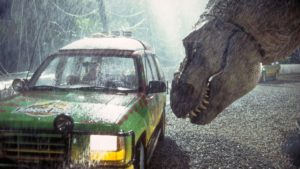
No, really – it can see you. Image – Universal Studios
“Inside the Tyrannosaurus rex’s 5-foot long skull is a complex brain that rivals the size of a human’s,” Waldron says. “With studies performed at the WitmerLab, we’ve identified the regions of the brain responsible for sensory input. Tyrannosaurus had particularly large lobes in the regions responsible for visual acuity and olfactory detection. Its eyes point forward stereoscopically, from high on its head, like a wolf or a bear. Its gigantic nasal cavity allowed it to detect living or dead prey for miles away.”
To be fair, though not covered explicitly in the movie, this supposed T. rex weakness was addressed in the original Jurassic Park novel. Crichton points out that frog DNA was used to fill the holes in the dinosaur’s genetic code – this was what allowed them to change sex and reproduce, as is seen in some frogs. Also seen in some frogs, their eyesight is attuned to movement, and it’s the frogs that can’t see prey that doesn’t move. A fully-functioning T. Rex without frog DNA mixed in? Yeah, they’d wonder why you were just…standing there, thinking it couldn’t see you.
All suggestions point to the idea that T. Rex had great binocular vision.
This plays back into the idea that dinosaurs ruled this planet millions of years ago. They occupied every environmental niche. They weren’t just dumb animals, ripe for man to travel back in time and tame the planet – they were the masters of the world. Life may always find a way, but evolution doesn’t suffer fools gladly. If you couldn’t hang in the Cretaceous or Jurassic, you didn’t. It was a place for winners.
As paleontologist Steve Brusatte writes in The Rise and Fall of Dinosaurs: The Untold Story of a Lost World, “I was taught that dinosaurs were big, scaly, stupid brutes so ill equipped for their environment that they just lumbered around, biding their time, waiting to go extinct. Evolutionary failures. Dead ends in the history of life … But these stereotypes are absurdly wrong.”
And while we’re talking about Brusatte, let’s go for a bonus:
#0: Jurassic Park didn’t just create dinosaurs on screen; it created scientists in theaters.
We’re biased here at The Science Of, and love to hear when pop culture inspires some real-world science, but this has to be the coolest. While millions of people have been thrilled with the adventures of dinosaurs in the Jurassic Park series of films, some of them went further than just being thrilled.
“Much of the new generation of paleontologists found their passion in the seats of a movie theater, as well as in the museum galleries of their childhoods,” Waldron said. “Steve Brusatte, author of Rise and Fall of the Dinosaurs among nearly a dozen other books, serves as one of the scientific advisors for Jurassic World: Dominion, and brought a powerful voice to showcase new and obscure dinosaur species, complex behaviors and relationships, and of course—feathers. He made the director, Colin Trevorrow promise to include feathered dinosaurs in the movie.”
We may be blending some correlation and causation here, but Brusatte was born in 1984, putting him at a ripe, young nine years old when the first Jurassic Park hit theaters in 1993. We’ll gladly put him in a theater as a kid that summer, staring at the screen in wide-eyed wonder. Brusatte himself has said many times that museums, universities and the field of paleontology in general owes Jurassic Park a debt of gratitude for making dinosaurs the coolest thing ever.
Other scientists that point to Jurassic Park as inspiration for their careers and life’s work include:
Ashley Hall @LadyNaturalist and her husband Lee @Paleeoguy
Myria Perez @paleontologica
Dean Lomax @Dean_R_Lomax
Filippo Bertozzo @Dino_Doctor
Alec Baines @alecosaurus
And literally hundreds more, including of course, Jimmy. This phenomenon is thoroughly covered in the upcoming documentary, “Why Dinosaurs,” by the father and son team of Tony and James Pinto. You can catch just some of the current generation of paleontologists (and more) talking about the impact of Jurassic Park in the 10-minute sizzle reel linked to below.
Jurassic World: Dominion is in theaters now.


